Showing Spotlights 321 - 328 of 556 in category All (newest first):
 Microbiology relates to nanoscience at a number of levels. Many bacterial entities are nano-machines in nature, including molecular motors like flagella and pili. Bacteria also form biofilms by the process of self-assembly. The formation of aerial hyphae by bacteria and fungi is also directed by the controlled and ordered assembly of building blocks. Also, the formation of virus capsids is a classical process of molecular recognition and self-assembly at the nanoscale. Nanoscience does have an impact on several areas of microbiology. It allows for the study and visualization at the molecular-assembly levels of a process. It facilitates identification of molecular recognition and self-assembly motifs as well as the assessment of these processes.
Microbiology relates to nanoscience at a number of levels. Many bacterial entities are nano-machines in nature, including molecular motors like flagella and pili. Bacteria also form biofilms by the process of self-assembly. The formation of aerial hyphae by bacteria and fungi is also directed by the controlled and ordered assembly of building blocks. Also, the formation of virus capsids is a classical process of molecular recognition and self-assembly at the nanoscale. Nanoscience does have an impact on several areas of microbiology. It allows for the study and visualization at the molecular-assembly levels of a process. It facilitates identification of molecular recognition and self-assembly motifs as well as the assessment of these processes.
Dec 9th, 2011
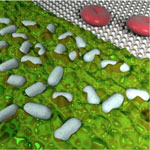 Surface-enhanced Raman spectroscopy (SERS) is a powerful research tool that is being used to detect and analyze chemicals as well as a non-invasive tool for imaging cells and detecting cancer. It also has been employed for label-free sensing of bacteria, exploiting its tremendous enhancement in the Raman signal. SERS can provide the vibrational spectrum of the molecules on the cell wall of a single bacterium in a few seconds. Such a spectrum is like the fingerprints of the molecules and therefore could be exploited as a means to quickly identify bacteria without the need of a time-consuming bacteria culture process, which typically takes a few days to several weeks depending on the species of bacteria. To practically apply SERS to the early diagnosis of bacteremia - the presence of bacteria in the blood - researchers have managed to capture bacteria in a patient's blood onto the SERS substrate.
Surface-enhanced Raman spectroscopy (SERS) is a powerful research tool that is being used to detect and analyze chemicals as well as a non-invasive tool for imaging cells and detecting cancer. It also has been employed for label-free sensing of bacteria, exploiting its tremendous enhancement in the Raman signal. SERS can provide the vibrational spectrum of the molecules on the cell wall of a single bacterium in a few seconds. Such a spectrum is like the fingerprints of the molecules and therefore could be exploited as a means to quickly identify bacteria without the need of a time-consuming bacteria culture process, which typically takes a few days to several weeks depending on the species of bacteria. To practically apply SERS to the early diagnosis of bacteremia - the presence of bacteria in the blood - researchers have managed to capture bacteria in a patient's blood onto the SERS substrate.
Nov 29th, 2011
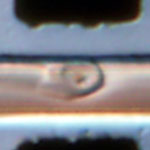 Graphene research papers are popping up left and right at what seems like an accelerating speed and growing volume. One of the areas that is seeing vast research interest is the biological interfacing of graphene for instance for sensor applications. Today, we are looking at another exciting graphene bio application where a graphene sensor is integrated with microfluidics to sense malaria-infected red blood cells at the single-cell level. Specific binding between ligands on positively charged knobs of infected red blood cells and receptors functionalized on graphene inside microfluidic channels induces a distinct conductance change. Conductance returns to baseline value when infected cell exits the graphene channel.
Graphene research papers are popping up left and right at what seems like an accelerating speed and growing volume. One of the areas that is seeing vast research interest is the biological interfacing of graphene for instance for sensor applications. Today, we are looking at another exciting graphene bio application where a graphene sensor is integrated with microfluidics to sense malaria-infected red blood cells at the single-cell level. Specific binding between ligands on positively charged knobs of infected red blood cells and receptors functionalized on graphene inside microfluidic channels induces a distinct conductance change. Conductance returns to baseline value when infected cell exits the graphene channel.
Nov 28th, 2011
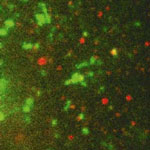 In nanomedicine, nanoparticles are used as vehicles for efficiently delivering therapeutic nucleic acids, such as disease-fighting genes and small interfering RNA (siRNA) molecules, into cells. But getting nanomedicines to their target sites inside cells is not the only challenge. It also is necessary to assess the intracellular processing of nanomedicines and the efficacy of their payload delivery - a task that is not exactly trivial given the complexity and dynamics of the mechanisms of endocytosis and intracellular trafficking. Researchers are therefore trying to develop robust and reliable tools to characterize and evaluate the intracellular processing of administered nanomedicines. As part of this effort, scientists have now introduced a quantitative approach to study live-cell endosomal colocalization dynamics of nanomedicines for gene delivery, based on single-particle tracking and trajectory-correlation.
In nanomedicine, nanoparticles are used as vehicles for efficiently delivering therapeutic nucleic acids, such as disease-fighting genes and small interfering RNA (siRNA) molecules, into cells. But getting nanomedicines to their target sites inside cells is not the only challenge. It also is necessary to assess the intracellular processing of nanomedicines and the efficacy of their payload delivery - a task that is not exactly trivial given the complexity and dynamics of the mechanisms of endocytosis and intracellular trafficking. Researchers are therefore trying to develop robust and reliable tools to characterize and evaluate the intracellular processing of administered nanomedicines. As part of this effort, scientists have now introduced a quantitative approach to study live-cell endosomal colocalization dynamics of nanomedicines for gene delivery, based on single-particle tracking and trajectory-correlation.
Nov 21st, 2011
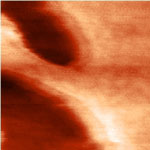 Lipids are the main component of the outermost membrane of cells. Their role is to seperate the inner and outer media of the cell and prevent any ionic current between these two media. Because of this last property, lipid layers can be thought of as good ultra-thin insulators that could be used in the development of electronic devices. So far though, because of their inherent instability in air, their use in advanced processes has been limited. This might change, though, since researchers in France have shown the possibility to stabilize by polymerization a lipid monolayer with a thickness of 2.7 nm directly at the surface of H-terminated silicon surface therefore opening a whole new world of possibilities of the use of these layers. Now, they reported the electrical performance of stabilized lipid monolayers on H-terminated silicon.
Lipids are the main component of the outermost membrane of cells. Their role is to seperate the inner and outer media of the cell and prevent any ionic current between these two media. Because of this last property, lipid layers can be thought of as good ultra-thin insulators that could be used in the development of electronic devices. So far though, because of their inherent instability in air, their use in advanced processes has been limited. This might change, though, since researchers in France have shown the possibility to stabilize by polymerization a lipid monolayer with a thickness of 2.7 nm directly at the surface of H-terminated silicon surface therefore opening a whole new world of possibilities of the use of these layers. Now, they reported the electrical performance of stabilized lipid monolayers on H-terminated silicon.
Oct 27th, 2011
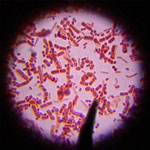 In order to enhance the utilization of nanomaterial in biological systems, it is very important to understand the influence they impart on cellular health and function. Nanomaterials present a research challenge as very little is known about how they behave in relation to micro-organisms, particularly at the cellular and molecular levels. Most of the nanomaterials reported earlier have demonstrated to be efficient antimicrobial agents against virus, bacteria or fungus. There are scarce research reports on the growth-promoting role of nanomaterials especially with respect to microbes. Recent findings, however, have challenged this concept of antimicrobial activity of nanoparticles.
In order to enhance the utilization of nanomaterial in biological systems, it is very important to understand the influence they impart on cellular health and function. Nanomaterials present a research challenge as very little is known about how they behave in relation to micro-organisms, particularly at the cellular and molecular levels. Most of the nanomaterials reported earlier have demonstrated to be efficient antimicrobial agents against virus, bacteria or fungus. There are scarce research reports on the growth-promoting role of nanomaterials especially with respect to microbes. Recent findings, however, have challenged this concept of antimicrobial activity of nanoparticles.
Oct 13th, 2011
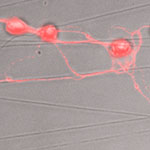 A main difference between central and peripheral nervous system is the lack of regeneration after a neurotrauma, leading to severe and irreversible handicaps. While biomaterials have been developed to aid the regeneration of peripheral nerves, the repair of central nerves such as the optic nerval or nerve cells in the spinal cord remain a major challenge for scientists. The ability to regenerate central nerve cells in the body could reduce the effects of trauma and disease in a dramatic way and nanotechnologies offer promising routes for repair techniques. Scientists have now attempted to rescue retinal ganglion cell death and enhance their regeneration using an electrospun material made of biofunctional nanofibers.
A main difference between central and peripheral nervous system is the lack of regeneration after a neurotrauma, leading to severe and irreversible handicaps. While biomaterials have been developed to aid the regeneration of peripheral nerves, the repair of central nerves such as the optic nerval or nerve cells in the spinal cord remain a major challenge for scientists. The ability to regenerate central nerve cells in the body could reduce the effects of trauma and disease in a dramatic way and nanotechnologies offer promising routes for repair techniques. Scientists have now attempted to rescue retinal ganglion cell death and enhance their regeneration using an electrospun material made of biofunctional nanofibers.
Oct 12th, 2011
 We are experiencing an unprecedented resurgence of interest in herbal healing, and 'herbal renaissance' is happening all over the globe. The Western world has begun to acknowledge the importance of traditional medicines as they symbolize safety in contrast to the allopathic medicines, which tend to produce undesirable side effects and are lacking in curative value. In the realm of medicine, nanotechnology holds enormous promise for benefitting society by potentially reducing the miseries of people suffering from grave illnesses and save a great number of lives. Traditional Oriental medicine would greatly benefit by integrating with the scientific advancements in medical science and diagnostics in concert with nanotechnology. This trinity may usher in a new era of affordable, safe and effective medicinal system.
We are experiencing an unprecedented resurgence of interest in herbal healing, and 'herbal renaissance' is happening all over the globe. The Western world has begun to acknowledge the importance of traditional medicines as they symbolize safety in contrast to the allopathic medicines, which tend to produce undesirable side effects and are lacking in curative value. In the realm of medicine, nanotechnology holds enormous promise for benefitting society by potentially reducing the miseries of people suffering from grave illnesses and save a great number of lives. Traditional Oriental medicine would greatly benefit by integrating with the scientific advancements in medical science and diagnostics in concert with nanotechnology. This trinity may usher in a new era of affordable, safe and effective medicinal system.
Sep 8th, 2011
 Microbiology relates to nanoscience at a number of levels. Many bacterial entities are nano-machines in nature, including molecular motors like flagella and pili. Bacteria also form biofilms by the process of self-assembly. The formation of aerial hyphae by bacteria and fungi is also directed by the controlled and ordered assembly of building blocks. Also, the formation of virus capsids is a classical process of molecular recognition and self-assembly at the nanoscale. Nanoscience does have an impact on several areas of microbiology. It allows for the study and visualization at the molecular-assembly levels of a process. It facilitates identification of molecular recognition and self-assembly motifs as well as the assessment of these processes.
Microbiology relates to nanoscience at a number of levels. Many bacterial entities are nano-machines in nature, including molecular motors like flagella and pili. Bacteria also form biofilms by the process of self-assembly. The formation of aerial hyphae by bacteria and fungi is also directed by the controlled and ordered assembly of building blocks. Also, the formation of virus capsids is a classical process of molecular recognition and self-assembly at the nanoscale. Nanoscience does have an impact on several areas of microbiology. It allows for the study and visualization at the molecular-assembly levels of a process. It facilitates identification of molecular recognition and self-assembly motifs as well as the assessment of these processes.
 Subscribe to our Nanotechnology Spotlight feed
Subscribe to our Nanotechnology Spotlight feed





